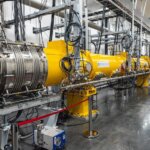China’s Ambitious Leap: Building the World’s First Orbital Supercomputer Network
In a move that signals a dramatic shift in both space technology and artificial intelligence (AI), China has launched the first phase of what it calls the Three-Body Computing Constellation—a massive network of AI-powered satellites designed to process data directly in orbit. This initiative, led by the aerospace startup ADA Space and the state-backed Zhijiang Laboratory, aims to deploy 2,800 satellites, each equipped with advanced AI models and high-speed laser communication systems. The project’s scale and ambition are unprecedented, positioning China at the forefront of a new era in orbital computing and global AI competition.
- China’s Ambitious Leap: Building the World’s First Orbital Supercomputer Network
- What Is the Three-Body Computing Constellation?
- Why Process Data in Space?
- Technical Innovations: How Does the Constellation Work?
- Applications: From Earth Observation to National Defense
- Environmental and Economic Impact
- Global Competition and Geopolitical Implications
- Expert Perspectives: A New Frontier for AI and Space
- Challenges and Future Prospects
- In Summary
The first 12 satellites, launched in May 2025 from the Jiuquan Satellite Launch Center, mark the beginning of a technological revolution. Unlike traditional satellites that primarily collect data and transmit it to Earth for processing, these new satellites are designed to analyze vast amounts of information in real time, directly in space. This approach promises to overcome longstanding bottlenecks in satellite communications and data management, with implications for industries ranging from emergency response to national defense and scientific research.
What Is the Three-Body Computing Constellation?
The Three-Body Computing Constellation is named after the famous science fiction novel “The Three-Body Problem” by Liu Cixin, which explores the complexities of gravitational systems and interstellar cooperation. The name reflects both the technical challenge and the ambition of the project: to create a distributed, space-based supercomputer that rivals or surpasses the most powerful terrestrial systems.
Each satellite in the constellation is a technological marvel. They are equipped with:
- An onboard AI model with 8 billion parameters, enabling sophisticated data analysis and decision-making.
- Computing power of up to 744 trillion operations per second (TOPS) per satellite, with the initial 12 satellites collectively achieving 5 peta operations per second (POPS).
- High-speed laser communication links capable of transferring data at up to 100 gigabits per second between satellites.
- 30 terabytes of onboard storage per satellite, forming a distributed mesh network in low Earth orbit.
- Specialized scientific instruments, including X-ray polarization detectors for astrophysical research and tools for real-time Earth observation and 3D terrain mapping.
When fully deployed, the network is projected to reach a staggering 1,000 POPS—one quintillion operations per second—potentially outpacing the world’s most advanced ground-based supercomputers, such as the El Capitan system in the United States.
Why Process Data in Space?
Traditional satellites face a critical limitation: bandwidth. Currently, less than 10 percent of the data collected by satellites ever makes it back to Earth, primarily due to limited transmission capacity and the scarcity of ground stations. This means that vast amounts of potentially valuable information are lost or delayed, limiting the effectiveness of satellite-based applications.
The Three-Body Computing Constellation addresses this challenge by enabling edge computing in space. Instead of sending raw data to Earth, satellites analyze and process information in orbit, transmitting only the most relevant results. This approach offers several key advantages:
- Reduced Latency: Real-time analysis allows for faster response in critical situations, such as natural disasters or military operations.
- Lower Transmission Costs: By sending only processed data, the network reduces the burden on ground infrastructure and saves energy.
- Environmental Benefits: Space offers natural cooling and unlimited solar power, eliminating the need for massive water-cooled data centers on Earth and reducing the carbon footprint of global computing.
- Global Accessibility: A space-based network can provide services to regions with limited terrestrial infrastructure, supporting international cooperation and development.
Jonathan McDowell, a Harvard astronomer and space historian, explained the significance of this shift:
“Orbital data centres can use solar power and radiate their heat to space, reducing the energy needs and carbon footprint. This is a very fashionable concept right now, and we can expect similar initiatives from the United States and Europe as the technology proves viable.”
Technical Innovations: How Does the Constellation Work?
The constellation’s architecture is built around several cutting-edge technologies:
- Distributed Mesh Network: Each satellite operates as a node in a larger network, sharing data and computational tasks through high-speed laser links. This design ensures redundancy, scalability, and resilience against failures.
- AI-Driven Processing: The onboard AI models can handle complex tasks such as image recognition, anomaly detection, and predictive analytics, enabling applications like real-time Earth observation, digital twin creation, and cosmic event detection.
- Scientific Payloads: In addition to AI processing, the satellites carry instruments for astrophysical research, including X-ray polarization detectors to study high-energy cosmic events like gamma-ray bursts.
- Energy Efficiency: The satellites are powered by solar panels and use the vacuum of space for passive cooling, avoiding the massive energy consumption and water usage of terrestrial data centers.
This combination of technologies allows the constellation to function as a single, massive supercomputer in orbit, capable of supporting a wide range of applications across industries and scientific disciplines.
Applications: From Earth Observation to National Defense
The potential uses for the Three-Body Computing Constellation are vast and transformative. Some of the key applications include:
- Real-Time Earth Observation: The network can generate up-to-date digital twins of Earth’s terrain, supporting agriculture, urban planning, disaster response, and environmental monitoring.
- Emergency Services: Rapid data analysis in orbit enables faster detection and response to natural disasters, such as earthquakes, floods, and wildfires.
- National Defense: The constellation’s ability to process intelligence in real time could provide a strategic advantage in military operations and surveillance.
- Scientific Research: Instruments onboard the satellites can study cosmic phenomena, contributing to astrophysics and space science.
- Commercial Services: The processed data can support industries like gaming, tourism, and smart city development, offering new business opportunities.
One notable feature is the constellation’s ability to create 3D digital twins—virtual replicas of physical environments—which can be used for simulation, planning, and immersive experiences. This capability is expected to benefit sectors ranging from emergency management to entertainment.
Environmental and Economic Impact
As global demand for computational power surges—driven by AI, big data, and cloud services—terrestrial data centers are consuming ever-increasing amounts of electricity. The International Energy Agency estimates that data centers worldwide could use over 1,000 terawatt hours of electricity annually by 2026, equivalent to the entire national power consumption of Japan. Google alone used nearly 20 billion liters of water in 2022 just to cool its data centers.
By moving computation into space, China’s orbital supercomputer network offers a potential solution to these environmental challenges. Satellites can harness solar energy continuously and dissipate heat into the vacuum of space, dramatically reducing the need for water and electricity. This approach not only lowers the carbon footprint of global computing but also sets a new standard for sustainable technology infrastructure.
Economically, the project is expected to drive growth in China’s high-tech sectors, supporting development zones like the Neijiang high-tech zone in Sichuan province. The data generated by the constellation will feed into local ecosystems focused on smart satellite services, AI, and digital innovation.
Global Competition and Geopolitical Implications
China’s rapid progress in space-based AI and supercomputing has not gone unnoticed by other global powers. The United States and Europe have conducted limited tests of orbital computing, but China’s deployment is the first operational attempt at such scale. This technological leap positions China as a leader in the emerging space-based AI race, with the potential to set new standards and influence the future of global data infrastructure.
The project also raises important questions about space governance, resource allocation, and international cooperation. As more countries and private companies pursue similar initiatives, the risk of orbital congestion and conflicts of interest grows. New frameworks may be needed to manage space traffic, ensure equitable access to orbital resources, and prevent the weaponization of space-based computing.
China has expressed openness to international collaboration, particularly with countries in the Global South. ADA Space and Zhijiang Lab have stated their intention to create a globally accessible and sustainable orbital infrastructure, inviting other organizations to participate in the network. This approach could foster new alliances and reshape the balance of power in the digital and space domains.
Expert Perspectives: A New Frontier for AI and Space
Experts across the globe are watching China’s orbital supercomputer project with a mix of admiration and concern. The scale of the initiative, combined with its technical sophistication, marks a turning point in how humanity approaches data processing and space exploration.
Wang Jian, director of Zhijiang Lab and a member of the Chinese Academy of Engineering, emphasized the strategic vision behind the project:
“Space is the new frontier for AI development. By bringing computational power into orbit, we can overcome the limitations of traditional systems and unlock new possibilities for science, industry, and society.”
Former Google CEO Eric Schmidt, who has advocated for orbital data centers through his investment in Relativity Space, highlighted the growing demand for computational power:
“The demand for computational power is so large that data centers could consume as much as 96 gigawatts globally by 2030. Moving data processing into space could be a game-changer for the industry.”
Jonathan McDowell, the Harvard astronomer, noted the environmental benefits and the likelihood of similar projects emerging worldwide:
“We can expect the United States and Europe to follow suit as the technology matures. Orbital data centers could significantly reduce the environmental impact of global computing.”
Challenges and Future Prospects
While the Three-Body Computing Constellation represents a major technological breakthrough, it also faces significant challenges. The deployment and maintenance of thousands of satellites require robust engineering, reliable launch capabilities, and effective coordination. Space debris and orbital congestion are growing concerns, necessitating careful management and international cooperation.
There are also questions about data security, privacy, and the potential for dual-use (civilian and military) applications. As space becomes increasingly contested, the need for transparent governance and responsible use of technology will be paramount.
Despite these challenges, the successful launch of the first 12 satellites demonstrates China’s commitment to pushing the boundaries of what is possible. The project is expected to unfold over several years, with each phase bringing new capabilities and opportunities for innovation.
In Summary
- China has launched the first phase of the Three-Body Computing Constellation, aiming to build the world’s most powerful orbital supercomputer network.
- The project involves 2,800 AI-powered satellites capable of processing data directly in space, reducing reliance on Earth-based infrastructure.
- Key innovations include high-speed laser communication, distributed mesh networking, and advanced AI models with 8 billion parameters per satellite.
- The constellation supports applications in Earth observation, emergency response, national defense, scientific research, and commercial services.
- Environmental benefits include reduced energy and water consumption compared to terrestrial data centers, thanks to solar power and passive cooling in space.
- China’s initiative positions it as a leader in the global AI and space technology race, with implications for international cooperation, governance, and competition.
- Experts predict that similar projects will emerge from other countries as the demand for computational power continues to grow.
- The project raises important questions about space governance, data security, and the future of digital infrastructure on a planetary scale.












